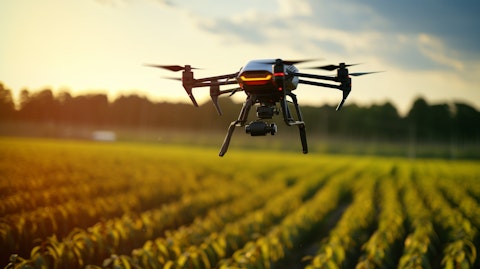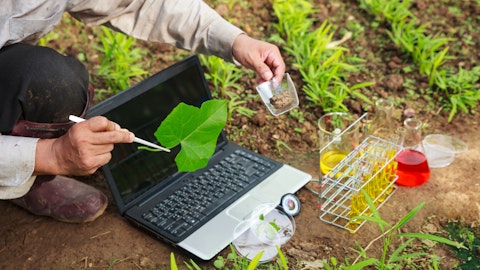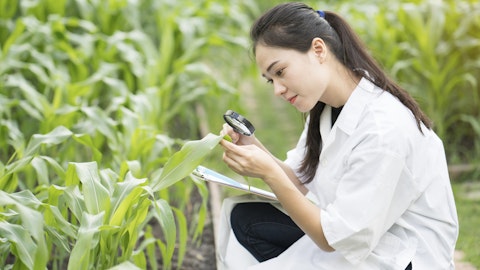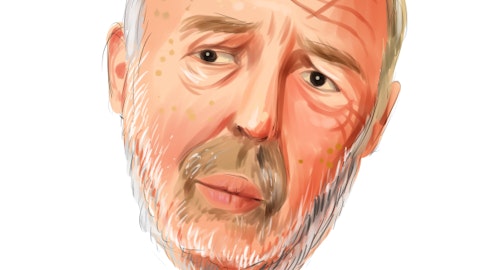Yield10 Bioscience, Inc. (NASDAQ:YTEN) Q4 2023 Earnings Call Transcript April 1, 2024
Yield10 Bioscience, Inc. misses on earnings expectations. Reported EPS is $-0.27 EPS, expectations were $-0.11. Yield10 Bioscience, Inc. isn’t one of the 30 most popular stocks among hedge funds at the end of the third quarter (see the details here).
Operator: Welcome to the Fourth Quarter and Full Year 2023 Financial Results and Business Update Conference Call for Yield10 Bioscience. During this call, participants will be in a listen-only-mode. The presenters will address questions from analysts today. [Operator Instructions] As a reminder, this conference call is being recorded. I would now like to turn the conference call over to your host, Yield10, Vice President of Planning and Corporate Communications, Lynne Brum.
Lynne Brum: Thank you, Alicia. Good afternoon, everyone. Welcome to the conference call. Joining me on the call today are President and CEO, Dr. Oli Peoples, Vice President of Research and Chief Science Officer, Dr, Kristi Snell and Chief Accounting Officer, Chuck Haaser. Earlier this afternoon, Yield10 issued our fourth quarter and full year 2023 financial results, as well as our 10-K. The press release as well as slides that accompany today’s presentation are available on the Investor Relations events section of our website at yield10bio.com. Let’s turn to slide 2. Please note, as part of our discussion today, management will be making forward-looking statements. These statements are not guarantees of future performance and therefore you should not produce undue reliance on them.

Investors are also cautioned that statements are not strictly historical, constitute forward-looking statements, and such forward-looking statements are subject to a number of risks and uncertainties that could cause the actual results to differ materially from those anticipated. These risks include risks and uncertainties detailed in Yield10’s filings with the SEC. The Company undertakes no obligation to update any forward-looking statements in order to reflect events or circumstances that may arise after the date of this conference call. I’ll turn the call over to Oli.
Oliver Peoples: Thanks, Lynne. Good afternoon everyone, and thanks for joining our call. Let’s turn to slide 3. We continue to make progress in our plans to commercialize sustainable products using the oilseed Camelina as a platform crop. We’re pursuing Camelina seed oil products for two market opportunities and value chains. Each product has its own scale requirements, timeline and value proposition. The first product is seed oil with high levels of the omega-3 fatty acids, EPA and DHA, and the market driver is the growing supply deficit. I’m going to refer to these as our omega-3 products for the rest of this presentation. The second product is Camelina seed oil, produces a low carbon intensity feedstock oil for biofuels. This market is driven by government policies, has a potential to be very large, and will require the production of tens of millions of acres of non-food oilseed cover crops like Camelina.
In early 2024, we revised our strategy for biofuels to focus on providing R&D services to third parties with the goal of generating service and licensing revenues from our advanced Camelina technologies. Today, we will provide an update on recent accomplishments, more detail on the development of omega-3 products, present fourth quarter and year end financials, and summarize key milestones. We will then open the call to questions. Let’s turn to slide 4 for progress on key ’24 business milestones. We achieved numerous milestones in 2023. We demonstrated a closed loop value chain from seed genetics to oil for sale. We progressed herbicide tolerance traits that included obtaining regulatory approval for growing HT Camelina from USDA-APHIS. We also stepped up our commercial and development efforts on our omega-3 products, which Kristi will review later on in this call.
See also 20 Most Buddhist Countries in Asia and 12 Most Populated Countries in South America.
Q&A Session
Follow Yield10 Bioscience Inc. (NASDAQ:YTEN)
Follow Yield10 Bioscience Inc. (NASDAQ:YTEN)
We were delighted with the recent USDA-APHIS approval for the growth of both omega-3 Camelina traits a year ahead of internal expectations. So kudos, kudos to our regulatory and technology team. Our commercial goals for omega-3 in 2024 include delivering samples of our omega-3 products, obtaining regulatory approval to use the feed, the oil and aquafeed in Chile, executing the commercial license with Rothamsted, and progressing partnership and update discussions. In biofuels, our goal is to execute R&D partnerships and license option agreements. In February this year, we signed our first license agreement with Vision Bioenergy Oilseeds. Vision is majority owned by a division of Shell Oil and we look forward to supporting Vision as the scale up HT Camelina production.
On the technology front, we reported positive data from the ongoing herbicide tolerance trials and we expect to announce that the US EPA has approved adding Camelina to a commercial herbicide label soon. This will complete the US regulatory requirements for large scale planting and herbicide use on our elite herbicide tolerance, Camelina. Let’s start with slide 5 for an overview of target markets and business models. The end markets for Omega-3 products include aquafeed, pet and animal feed, human nutrition and pharmaceuticals, based on which we anticipate being able to build an omega-3 products business with over a billion in annual revenue over time. Near term, our business model is to produce omega-3 oils and sell them into aquafeed. For that market we believe we can scale to around 150,000 to 300,000 acres over the next 5 years, generating $150 to $300 million of revenue with good margins.
This assumes we begin commercial production sometime in ’25, ’26. We expect omega-3 oil margins to be a multiple of those achievable in biofuel markets. Our R&D services and licensing strategy for biofuels is designed to enable better resource third parties to invest in accelerating grower adoption of Camelina and establishing large scale value chains. With over 44 million acres of Camelina potential, we believe there’s an opportunity to generate significant licensing revenue from our technologies. Let’s now turn to slide 6, establishing the Camelina oil value chain. An important commercial accomplishment in ’23 was demonstrating closed loop production of Camelina oil, validating the value chain from Camelina seed genetics all the way to oil product available for sale.
As a result of this investment in establishing this core operating capability, we also gain necessary experience which will benefit our omega-3 products business. In addition to the over 1200 acres of winter Camelina contracted in Q4, our seed Ops team is already engaged in outreach to growers to generate interest in planting spring Camelina. Based on our revised biofuel strategy, we are using a seed sales model and providing agronomy support to growers. This will expand our Camelina grower network, the foundation for our omega-3 products business. Let’s turn to slide 7, omega-3. The omega-3 fatty acids ALA, EPA, and DHA are essential for human health and wellness. ALA is abundantly available from vegetable oils, including canola, soybean, flaxseed, and Camelina.
EPA and DHA, on the other hand, are only available from fish oil extracted from ocean harvested fish or krill. Markets for fish oil are driven by their EPA and DHA omega-3 content. Aquafeed, the largest market by volume, consumes around 75% of total fish oil production, mainly for salmon, is growing at 3% per year. The market for products for human nutrition, which includes everything from omega-3 capsules to omega-3 beverages, is growing around 7% per year. Pet food and animal feed are also significant omega-3 markets and there are effective small volume, high value markets for fish oil derivatives used in pharmaceuticals. Since announcing the execution of our exclusive option to the omega-3 Camelina technology in October last year, we have received inbound increase from industry leaders in each of these markets, many of whom have been following the Rothamsted technology development for some time.
We are currently in active discussions with a number of them. Omega-3s are important in aquafeed to protect the health of the fish during production and the value of the final product as a healthy protein and source of dietary omega-3, and we believe there is considerable scope for increasing levels of omega-3s in aquafeed diets. Bottom line ,increasing the use of omega-3s for these markets requires new sources of supply. Let’s turn to slide 8, the omega-3 deficit. Across the aquaculture industry, there’s an increased emphasis on sourcing sustainable aquafeed ingredients and transitioning from processing ocean-harvested fish to produce fish meal and fish oil to land-based sources of protein and omega-3s. The fish oil supply and demand chart on the left was taken from a recent UBS analyst report, and the general reflects the following feedback we have heard in our discussions with industry players.
Demand will continue to grow for the foreseeable future. Supply for fish oil will remain flat, the expectations of higher prices and price volatility. An omega-3 supply deficit of around 500,000 tonnes per year is projected by 2030 and they believe that Yield10s omega-3 Camelina can play a major role in sustainably addressing this deficit. Let’s turn to slide 9. Camelina sustainable omega-3 growth platform. The left side of the chart shows the levels of EPA and DHA Omega-3s in fish oil from different sources including anchovy oil, industry gold standard and northern hemisphere fish oil, which is mainly used in aquafeed. We believe algal sources of omega-3s will remain high cost and limited in scale. Engineered oilseeds represent a sustainable, scalable and cost effective way to provide new sources of omega-3 and we believe our omega-3 technology has the potential to capture a significant share of the growth in this market.
Nuseed, which is part of the Australian ag company Nufarm, has been a pioneer in this field, producing an omega-3 oil product using engineered canola with around 10% DHA. Analysts project that their production – as their production neighbors [ph] ramp up, with an oil selling price of around $2,400 per tonne, Nuseed could generate around $260 million in annual omega-3 product revenue by ’27, ’28. In June last year, Nuseed obtained regulatory approval to use their DHA omega-3 canola oil in aquafeed in Norway. Norway produces around 60% of farmed salmon and this was the first approval of a GMO ingredient for aquafeed in that country. Hopefully, new Nuseed’s accomplishment in overcoming a major regulatory hurdle will broaden adoption of plant based omega-3s, paving the way for our Camelina products.
Congrats to them and a job well done. Yield10’s EPA DHA omega-3 product is very similar to canola [ph] hemisphere fish oil and has higher potential as a drop-in replacement in aquafeed, which will be our near term market focus. The EPA product has been – has between 20% and 30% EPA content and may be blended with non fish sources of DHA and aquafeed in the near term, but will likely be used to produce higher value EPA esters over time. Let’s turn to slide 10 for an overview of our omega-3 product development status. In the fourth quarter of last year, we announced that we had executed an exclusive option for an exclusive global license and are currently working closely with Rothamsted to finalize the license for the omega-3 Camelina technology.
Prior work by Rothamsted demonstrated that the EPA DHA omega-3 product to be an effective replacement for fish oil and aquafeed trials for salmon. Human clinical studies carried out with this product also demonstrated it was effective in human diets, delivering the same target levels of EPA and DHA as fish oil. It also doesn’t smell or taste like fish. Breeding of our HT treats into the omega-3 Camelina is fairly advanced and this will be followed by seed scale-up of HT omega-3 Camelina lines for large scale planting. With regulatory approvals in hand and the closed loop production capabilities established last year, we believe that the products and production have been derisked. Our vision is to build a high growth business producing clean omega-3 ingredients for aquaculture and then expanded to additional market opportunities.
I will now turn the call over to Kristi for an update on our technology progress.
Kristi Snell: Thanks, Oli and good afternoon everyone. Let’s turn to slide 11. In early 2023, the technology to produce omega-3 oils containing EPA for both EPA and DHA was transferred from Rothamsted to Yield10. Since this time, we have focused on seed scale-up, producing omega-3 oil samples and adding herbicide tolerance to the omega-3 lines. In the fall of 2023, we planted approximately 50 acres of the Camelina line producing EPA in its seed oil with the seed production partner located in Chile. This slide shows photos from the harvest in late January of 2024. The next step with this seed is to extract omega-3 oil from the grain to supply samples to partner prospects. In 2024, we plan to execute on our scale-up of both the EPA and EPA plus DHA producing Camelina with the goal of being ready for an initial commercial launch in the 2025, 2026 timeframe.
Let’s now turn to slide 12. I am pleased to report that we have cleared all of the key regulatory hurdles to grow our genetically engineered Camelina with traits for either herbicide tolerance or for producing EPA or EPA plus DHA omega-3 oils in the US. This was achieved by submitting multiple regulatory status review, or RSR documents for the different traits. We received feedback in late 2023 and early 2024 that USDA-APHIS does not consider these traits to be regulated. Details are summarized in the slide. We expect to announce shortly the US Environmental Protection Agency approval add Camelina to the label of a glufosinate product produced by another company. The significance of these multiple regulatory approvals is that we can mix and match these traits through simple breeding procedures, and the resulting lines will also not be considered to be regulated by USDA-APHIS in the US.
In addition to having clearance to plant omega-3 Camelina, we need regulatory approvals to sell the oil for use in aquafeed. Chile is a major market for omega-3 oils, and we plan to seek regulatory approval for our EPA oil with a filing plan for 2024. In the initial phase of production in 2025 into 2026, when we will still be at relatively small scale, we plan to use the residual protein meal for markets that do not require feed approval. As a result of our 2023 production of oil for biofuels, we identified a number of markets for Camelina meal where we can recover some of the costs by selling the meal at a discount to feed use. We also identified and established relationships with small scale oilseed crushers, which we can also use for early omega-3 Camelina oil production.
As production acres ramp up, it will be important to have higher value commercial markets for the high protein Camelina seed meal that remains after removal of the oil. Here, the regulatory path includes field trials and seed compositional analysis to produce the data package to demonstrate that the seed composition of our engineered lines is within the range of conventional Camelina. In time, Yield10 plans both a self-assessment of this data package and a submission to FDA for reviewing. Let’s now turn to slide 13. In 2021, we prioritized the engineering at Camelina with herbicide tolerance based on our belief as well as grower feedback that herbicide tolerance would be necessary for weed control to enable large scale commercial production at Camelina.
I thought it would be useful today to recap our journey from field testing to commercial seed production through our glufosinate tolerant spring Camelina because it highlights our capabilities in Camelina development. In 2022, we conducted our first field trial of spring Camelina engineered for glufosinate tolerance, where we planted multiple events and determined which events had the best performance. In the summer of 2022, we announced the plants were sprayed with glufosinate and did not sustain any meaningful injury. Little to no growth was observed in control plots marked with red dots in the photo on the slide as expected. This was a significant milestone in our program. We selected the top commercial quality Camelina line, as well as backups and continued field testing and seed scale-up over the next several growth seasons.
In the fall of 2023, we were in position to plant 74 acres of herbicide tolerant Camelina during the Contra season in Chile to scale-up seed. In January of 2024, the crop was harvested, cleaned, and bagged and shipped back to the US. In summary, we went from initial field testing of the glufosinate trait to having planting seed packaged in a thousand pound totes in approximately 2 years. This progress enabled licensing of our herbicide tolerance traits to Vision Bioenergy Oilseeds in early 2024. Going through this process has provided our team with the experience and insights to develop and scale up new varieties of Camelina, and we believe this will serve us well going forward in our development of the omega-3 trait. Let’s now turn to slide 14.
In 2023, we planted our first field trial of winter Camelina engineered with glufosinate tolerance for weed control. The winter Camelina were planted in the fall of 2023, and the field plots were sprayed with glufosinate. Photos on the slide show the result of these fall glufosinate sprays. Our winter Camelina engineered with herbicide tolerance remained healthy, while our plots of Camelina without the herbicide tolerance trait did not survive the spray. In the spring, we planned to spray the field plots again with glufosinate for broadleaf weed control, mimicking the weed management protocol we believe growers will use. In the fall of 2023, we also confirmed that our stacked herbicide tolerant winter Camelina with both glufosinate and group 2 soil residue tolerance performed well when grown on field plots pretreated with group 2 soil herbicides.
These field tests simulate the planting of Camelina on land containing group 2 herbicide residues from use on a previous crop. We plan to spray our test plots with glufosinate for weed control in the spring to demonstrate the efficacy of both stacked traits. We plan to harvest all of our winter Camelina field test plots in early summer, and we will evaluate seed yield, soil content, herbicide tolerance, and overall agronomy. I’d like to thank our team for their outstanding contributions in 2023, which are accelerating our path forward in 2024. Chuck, I’ll hand the call over to you.
Chuck Haaser: Thanks, Kristi, and good afternoon, everyone. Let’s turn to slide 15 for our fourth quarter and full year 2023 financial results. We ended the fourth quarter of 2023 with $1.1 million in cash and cash equivalents. In connection with the commercial license and completion of certain deliverables, Vision will make payments totaling $3.0 million to us. In March, we raised an additional $1.2 million net based on a warrant inducement transaction. We expect that our cash on hand, including proceeds from the offering, will support our operations into the second quarter of 2024. We are engaged in a dedicated and ongoing effort to secure additional funds in the very near term in order to continue our operations. Our net operating cash used for operating activities was $1.7 million for the fourth quarter of 2023 and $10.1 million for the full year.
Now let’s review the fourth quarter and full year 2023 operating results. For the fourth quarter of 2023 the company reported a net loss of $3.3 million, or $0.27 per share, as compared to a net loss of $3.3 million or $0.67 a share for the fourth quarter of the previous year. As expected, due to the completion of our Department of Energy grant during our first quarter of 2023, we did not report grant revenues during the fourth quarter of 2023. We reported $0.1 million in grant revenue in the fourth quarter of 2022. R&D expenses were $2 million during the fourth quarter of 2023, and during the fourth quarter of 2023, we recorded $110,000 in payments received or due to us from shipments of seed and harvested grain to growers and offtake [ph] partners as an offset to an to our R&D expenses.
R&D expenses in the fourth quarter of 2022 were $1.9 million. G&A expenses were $1.4 million for the fourth quarter of 2023, as compared to $1.4 million in the fourth quarter of 2022. Now, for the full year ended December 31, 2023, the company reported a net loss of $14.5 million or $1.82 per share, compared to a net loss of $13.6 million or $2.76 per share during the 12 months ended December 31, 2022. Grant revenue from the completed DOE grant was $0.1 million and $0.5 million for 2023 and 2022, respectively, and research and development expenses were $8.3 million and $7.8 million for the 2023 and 2022 years, respectively, and G&A expenses were consistent at $6.2 million during both years. For more details on our financial results, please refer to our earnings release.
Oli, back to you.
Oliver Peoples: Thanks, Chuck. Let’s now turn to slide 16 for a view of upcoming milestones. Our immediate focus is on commercializing our omega-3 products. These essential fatty acids are supply-constrained even as demand continues to grow for use in aquaculture feed, pet food, nutraceutical and pharmaceuticals. In ’24 we plan to deliver our first omega-3 product samples and file for regulatory approval of oil in Chile to support its use in aquafeed. While the scale-up of our omega-3 Camelina will also get underway, even as the technical work continues to breed herbicide tolerance omega-3 lines for large scale production. We look forward to completing the commercial license with Rothamsted and working with companies like BioMar and others to form partnerships and secure offtake agreements for omega-3 oil for use in aquafeed, pet food and other markets.



